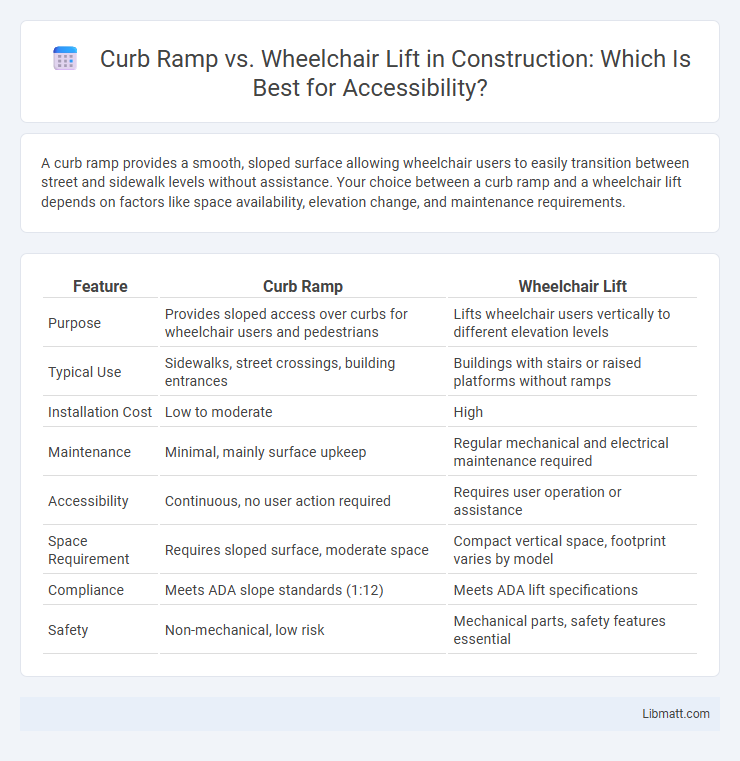A curb ramp provides a smooth, sloped surface allowing wheelchair users to easily transition between street and sidewalk levels without assistance. Your choice between a curb ramp and a wheelchair lift depends on factors like space availability, elevation change, and maintenance requirements.
Table of Comparison
| Feature | Curb Ramp | Wheelchair Lift |
|---|---|---|
| Purpose | Provides sloped access over curbs for wheelchair users and pedestrians | Lifts wheelchair users vertically to different elevation levels |
| Typical Use | Sidewalks, street crossings, building entrances | Buildings with stairs or raised platforms without ramps |
| Installation Cost | Low to moderate | High |
| Maintenance | Minimal, mainly surface upkeep | Regular mechanical and electrical maintenance required |
| Accessibility | Continuous, no user action required | Requires user operation or assistance |
| Space Requirement | Requires sloped surface, moderate space | Compact vertical space, footprint varies by model |
| Compliance | Meets ADA slope standards (1:12) | Meets ADA lift specifications |
| Safety | Non-mechanical, low risk | Mechanical parts, safety features essential |
Introduction: Curb Ramp vs Wheelchair Lift
Curb ramps provide a smooth, inclined surface that allows wheelchair users to transition seamlessly from street level to sidewalk, enhancing accessibility in outdoor spaces. Wheelchair lifts offer vertical elevation, enabling users to overcome steps or raised platforms where ramps are not feasible due to space or steepness constraints. Both solutions are essential for inclusive design, with curb ramps suited for gradual elevation changes and wheelchair lifts ideal for overcoming significant height differences in accessibility infrastructure.
Accessibility Solutions Overview
Curb ramps provide a smooth, sloped transition from sidewalks to streets, essential for wheelchair users and individuals with mobility impairments to navigate urban environments safely. Wheelchair lifts offer vertical elevation assistance for entering or exiting buildings where ramps are impractical due to space constraints or steep elevation changes. Both accessibility solutions comply with ADA standards, ensuring inclusive access by addressing different architectural challenges and user needs.
How Curb Ramps Work
Curb ramps facilitate wheelchair access by providing a smooth, sloped transition between sidewalks and street levels, eliminating obstacles at curbs. They are designed with specific slope ratios, typically 1:12, to ensure safety and ease of use for wheelchair users. Unlike wheelchair lifts, curb ramps require no mechanical operation, relying solely on the ramp's geometry to enable mobility.
How Wheelchair Lifts Function
Wheelchair lifts operate by mechanically raising and lowering a platform to help individuals with mobility challenges access elevated surfaces or entrances. These lifts are powered by electric, hydraulic, or pneumatic systems, ensuring smooth and safe vertical movement. Your choice between a curb ramp and a wheelchair lift depends on the height difference and space available for installation.
Key Differences Between Curb Ramps and Wheelchair Lifts
Curb ramps provide a smooth, angled surface to transition from sidewalk to street, enabling wheelchair users to navigate small elevation changes independently. Wheelchair lifts mechanically raise and lower users for significant height differences where ramps are impractical due to space or slope constraints. The primary difference lies in curb ramps being passive, slope-based solutions, while wheelchair lifts offer active, vertical mobility assistance.
Advantages of Curb Ramps
Curb ramps provide a simple, cost-effective, and permanent solution for accessibility, allowing smooth and independent navigation for wheelchair users over street curbs. They require minimal maintenance compared to wheelchair lifts and are less prone to mechanical failure or power outages. Your accessibility improvements with curb ramps enhance safety and ease of movement in public and private spaces alike.
Benefits of Wheelchair Lifts
Wheelchair lifts provide seamless vertical access where space constraints prevent the installation of curb ramps, making them ideal for homes and businesses with limited exterior areas. These lifts enhance safety by minimizing the risk of falls and offering smooth, automated elevation changes for users with mobility challenges. Your property gains increased accessibility and compliance with ADA standards by incorporating wheelchair lifts in addition to or instead of curb ramps.
Factors to Consider When Choosing
When choosing between a curb ramp and a wheelchair lift, consider factors such as available space, budget, and mobility needs. Curb ramps require sufficient ground space and are more cost-effective, while wheelchair lifts provide vertical elevation in limited areas but involve higher installation and maintenance costs. Assess the terrain, user capabilities, and local accessibility regulations to determine the most practical and compliant option.
Compliance with Accessibility Standards
Curb ramps and wheelchair lifts both play vital roles in ensuring compliance with accessibility standards such as the Americans with Disabilities Act (ADA). Curb ramps must meet specific slope, width, and surface requirements to provide a smooth transition from sidewalks to street level for wheelchair users. Your choice between the two depends on site constraints and the level of accessibility needed, with wheelchair lifts offering vertical elevation in areas where ramps are impractical.
Conclusion: Choosing the Right Accessibility Option
Curb ramps provide a cost-effective and simple solution for short elevation changes, ideal for outdoor public spaces and sidewalks, ensuring smooth wheelchair access. Wheelchair lifts are more suitable for steep or vertical height differences, offering safety and independence in environments where ramp installation is impractical. Evaluating site conditions, user needs, and budget constraints ensures the selection of the most effective and compliant accessibility option.
Curb ramp vs wheelchair lift Infographic

 libmatt.com
libmatt.com